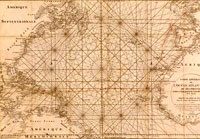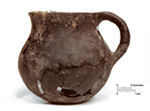  June 2007 NewsletterIn this issue we present the following articles, news, announcements, and reviews: Early African-American Pottery in South Carolina: |
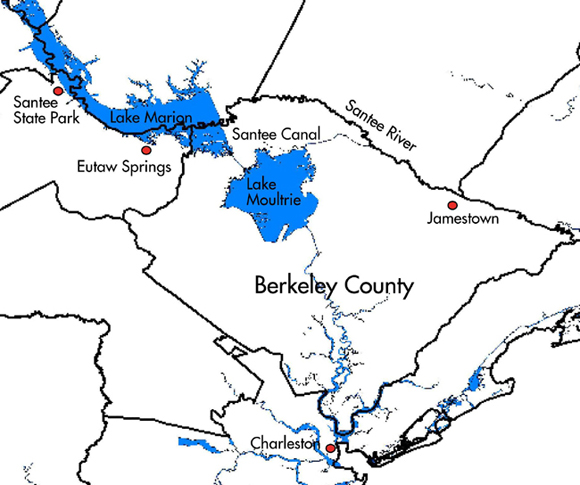 |
| Figure 1: Map showing locations associated with the Santee limestone karst region. |
Accounts of "Cymbee" in South Carolina
Edmund Ruffin
Edmund Ruffin's (1794-1865) travels through South Carolina were part of his overall efforts to keep the slave economic system viable through agricultural reform. Because of rather severe economic depressions during the previous 25 years and the exhaustion of fields due to monocropping, Ruffin became preoccupied with marling and liming to ameliorate the acidic and depleted fields in the South (Matthew 1992: xi-xii).
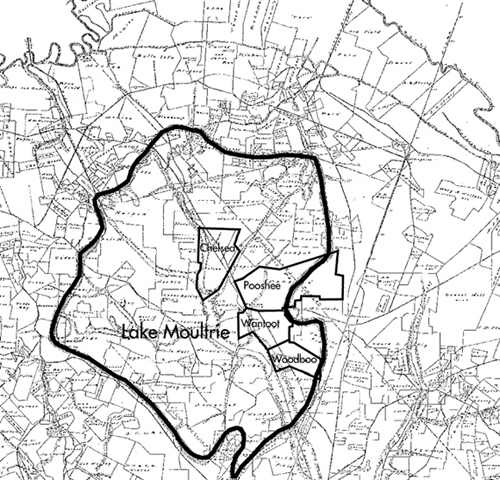 |
| Figure 2: Map of Lake Moultrie showing known locations of Woodboo, Wantoot, Pooshee, and Chelsea Plantations. |
On March 25, 1843 Ruffin visited the plantation of Mr. Robert Mazyck, the owner of Woodboo Plantation. It was in this vicinity that he had noticed numerous sinks, subterraneous passages of water, and limestone boiling springs. Ruffin referred to the sinks and springs as "fountains" (Figure 3).
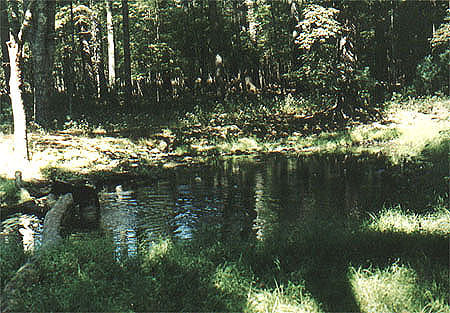 |
| Figure 3: Example of a limestone sinkhole. |
At the plantation, a fountain was cared for as a part of the landscaping. It was at that fountain the Ruffin first heard of a belief amongst the slaves regarding water spirits. Each fountain of any considerable size was believed to be inhabited by what they called a "cymbee." This was Ruffin's best guess at a spelling and he mentions that he doubts if the word was ever written before. Each fountain had its own cymbee, with each "having a different size, appearance, and set of habits" (Matthew 1992: 166).
A slave driver that accompanied Ruffin told him that he had never seen the Woodboo cymbee, but that others had told him that it was web footed like a goose. Another elderly slave stated that, as a very young boy he had seen one at another fountain. Ruffin wrote that the man said the cymbee was "seated on a plank which was laid across the water, & that the long brown hair of her head hung down so low, & so covered her face & whole body & limbs, that he saw no other feature; nor could he answer to my question whether she as a white or a negro cymbee, except as may be inferred from her long hair." After seeing her, she glided into the water and disappeared. The man admitted that he was "so young and so frightened, that his recollection of what he saw was rather vague" (Matthew 1992: 166). At Pooshee plantation on the Santee Canal not too far from Woodboo, Ruffin stated that a young slave boy went to a fountain for water late at night and was very frightened by a cymbee who was running around and around the fountain.
Although few witnesses to the appearance of cymbees were found by Ruffin, he stated that they are generally believed by the slaves to be frequent and numerous. It should be noted that part of the superstition was that it was bad luck for anyone who saw one to "tell of the occurrence, or refer to it; & that his death would be the certain penalty, if he told of the meeting for some weeks afterwards" (Matthew 1992: 166).
According to the local slaves, the Woodboo cymbee was only seen when the sunshine was "right up & down." At other fountains, they appeared at night. They were usually found sitting on a low bridge or plank crossing the water or on the edge of a steep side (Matthew 1992: 166).
Ruffin noted, "in regard to matters of fact of these fountains from the lime-rock, and which facts are in strict accordance with the cavernous foundation which I suppose, these fountains sometimes suddenly disappear entirely, & in other places, new fountains burst out. When the former occurs, the negroes believe that the cymbee has died, or has been offended & abandoned her residence. When Dr. Ravenel enclosed his fountain with masonry & confined & raised its water, an old half breed Indian of the neighborhood, who was half negro in blood, & wholly in habits & superstition, remonstrated with him, upon the ground that the cymbee might be made angry & leave her haunt, & that then the spring would be dried. Unluckily for the story, the fountain continues to flow as previously" (Matthew 1992: 167). At the end of Ruffin's account, Matthew notes that in Indian folklore dwarves, water babies, and old women variously inhabit springs and other wet places.
Robert Wilson
Robert Wilson (1838-1924) was born and educated in Charleston and, as a young man, practiced medicine in St. John's Berkeley Parish. Prior to the Civil War he trained to become an Episcopalian minister, but during the war served as a doctor at Wayside Hospital in Columbia. Afterwards he served as rector at the Episcopal Church in Stateburg, then Maryland, and later back to Charleston. In his "Half Forgotten By-Ways" he describes a Christmas he spent at Pooshee Plantation. The year is unknown, but the account was written in 1876 and published fifty years later. In examining Ruffin's diary, Ruffin makes no reference to Wilson and it is unknown if they ever met. Wilson obviously knew the owners of Pooshee -- the Ravenels - and his accounts of cymbee spirits closely corresponds to that of Dr. Henry Ravenel's son, the younger Henry Ravenel, where he may have picked up the story.
Wilson notes that an octagonal brick wall enclosed the spring at Pooshee. He states that two miles away on Woodboo Plantation there were two similar basins that were connected by a shallow stream (Wilson 1926: 155). About a mile in the opposite direction, through a belt of wet pinelands, there were a dozen or more of these ponds. The largest of them was no more than six by nine feet and are not drained by any stream. Others existed at the famous Eutaw Springs 15 miles away and 10 miles beyond that were the last of these basins in the chain (Wilson 1926: 156).
He states that the slaves "have peopled these fountains with spirits which they call cymbies, akin to the undine and the kelpie. On Saturday nights you may hear a strange, rhythmic thumping sound from the spring, and looking out you may see by the wild, fitful glare of lightwood torches dark figures moving to and fro. These are the negro women at their laundry work, knee deep in the stream, beating the clothes with heavy clubs. They are merry enough when together, but not one of them will go alone for a piggin of water and if you slip up in the shadow of the old oak and throw a stone into the spring, the entire party will rush away at the splash, scream with fear convinced the cymbee is after them" (Wilson 1926: 156-157).
Henry William Ravenel
Henry William Ravenel (1814-1887) was the son of the owner of Pooshee Plantation, which was the ancestral home of that family. The young Ravenel was not only a planter, but also a botanist and scientist. Ruffin probably knew Henry as "just a young scientist-planter that was interested in agricultural improvements" (Matthew 1992: 333). The young Ravenel was a strong supporter of Ruffin's previously mentioned survey.
In Henry Ravenel's "Recollections of Southern Plantation Life" (Ravenel 1936:776), he states, "there was a general belief in the guardian spirits of water called cymbee among the slaves." He stated, "I have never been able to trace the word to any European language and conclude it must be African. If anyone disturbs the spring, the Cymbee would be angry. If it was destroyed or much injured from any cause, the Cymbee would leave it, and the waters would dry up. The Cymbees were proportionate in size to the spring" (Ravenel 1936: 776).
Ravenel then provides a nearly identical story regarding the women washing clothes and it is probably from him or another Ravenel family member that Robert Wilson got his story. He concluded "they all have entire faith in Cymbee -- and one of the old men told me with a grave face that he had seen it. On inquiry about its appearance, he described the old traditional mermaid -- a female form -- half fish -- sitting on the banks and combing out its long tresses" (Ravenel 1936: 776).
Clara Milligan
Pooshee Plantation comes up again as a location occupied by water spirits in a much later context. A black woman by the name of Clara Milligan warned some white children who were playing beside of a pool. She warned "Got to be really carefully if you go in that water. Simbi'll get you." One of the children, Nina Langley remembered that warning occurred sometime between 1915 and 1921. Her daughter, Patricia Dwight of Charleston, brought this story to Robert Farris Thompson's attention, who published this brief account (Thompson 1998: 61; 301).
Ras Michael Brown's Discussion of the Ruffin AccountIn a paper presented at the 2000 fall meeting of the Southeastern Regional Seminar in African Studies, historian Ras Michael Brown discusses the Ruffin example. Brown contends that "West-Central African nature deities, called simbi spirits in Kikongo, served the enslaved people of the early Lowcountry as spiritual benefactors around which captives of diverse African origins and those born in the Lowcountry built their communities" (Brown 2000). Brown specifically points to a Kongo proverb that notes, "where your ancestors do not live, you cannot build your house." Brown argues that nature spirits allowed those who were either strangers to the area or lacked ties with named ancestors to "still have access to the agents of Other Worldly powers and to feel attached to the land where they lived."
Brown states he believes that "cymbee" is an attempt to represent the pronunciation of the Kikongo word simbi. The words not only match in sound but also in meaning. Nature spirits known as bisimbi (plural of simbi) often take the form of water spirits and he believes the lowcountry example is unmistakably derived from West-Central African understanding of simbi spirits. As previously mentioned, although presumably knowing nothing about African culture, Henry Ravenel believed that the word was African.
Brown argues that West-Central Africans were particularly influential in the cultural development of the slave society because they arrived during times that corresponded with the formative phases in the growth of slavery and not because they numerically dominated the population. This argument is laid out in his article "'Walk in the Feenda': West-Central Africans and the Forest in the South Carolina-Georgia Lowcountry" (Brown 2002) and should be consulted for further information.
He suggests that simbi spirits may have offered West-Central African slaves powerful spiritual benefactors within slavery. They may have focused their anxieties over health and fertility on the simbi spirit. The existence of simbi in the South Carolina lowcountry exhibits the concerns African slaves had about the maintenance of community and their spiritual and material survival. As such they were vital features of the mental and physical landscape (Brown 2000).
Brown (2000) believes that the existence of simbi in South Carolina is not an "Africanism," but rather a mechanism for community building within the system of American plantation slavery. Regardless of the cultural plurality that existed during slavery, it "transformed into a complex African-Lowcountry culture that incorporated various influences into a framework that had been established by West-Central African founders. In this process the fundamentally similar perspectives concerning nature spirits that Africans from many regions brought with them were retained by ultimately expressed in the idiom of West-Central African Kongo culture."
Bisimbi in West-Central AfricaIn Kongo, bisimbi inhabit rocks, gullies, streams, and pools, and are able to influence the fertility and well being of those living in the area. They are closely related with persons born abnormally (called baana ba nlongo) and minkisi which are magical devices or "power objects" (MacGaffey 2002: 212). They are powered by nature spirits such as bisimbi.
The difficulty in categorizing the manifestations of these spirits is illustrated by a 1915 KiKongo text, which states:
What are bisimbi? They have other names, too. Some are called python, lightning gourd or calabash, mortar or a sort of pot. The explanation of their names is that they are water spirits (nkisi mia mamba). The names of some of these minkisi are: Na Kongo, Ma Nzanza, Nkondi and Londa. They have many appearances of all kinds. Some are seen to be green, or red, black, or perhaps in spotted or sparkling colors. The body in which they are appealed to is of three or four kinds: 1) the body of a person 2) of a snake such as a python or viper 3) a calabash or gourd 4) of wood or pottery. Sometimes a spark of fire (quoted in MacGaffey 2002).
MacGaffey (2002: 213) states that they affect the lives of people in three modes. "They are the tutelary spirits of particular territories, they become incarnate as twins and other special children, and they are the principal animating forces in minkisi. Since the destruction of indigenous polities under colonial rule, the great, named spirits are scarcely remembered. Nowadays, bisimbi are most familiar as anonymous spirits able to cause trouble if they are not treated with respect."
The accounts of "cymbees" in St. John's Berkeley Parish of South Carolina clearly demonstrate the belief in West-Central African simbi water spirits and their association with limestone sinkholes in the area.
How African-Americans envisioned the functions of these spirits in the sinkholes is not obviously clear. The references from the nineteenth and early twentieth century do not elaborate in this regard. The only conclusion one might draw from reading the accounts is that they were creatures to be feared. At the same time, however, their presence was desired as exhibited by the admonishing statement that enclosing the fountain at Woodboo would make the cymbee angry and it would leave. Brown (2000) suggests that the fear "cymbee" spirits invoked did not alienate people, but simply "confirmed that nature spirits and the sites associated with them were legitimate channels of Other Worldy power." As later generations continued to have many of the same concerns about community maintenance and spiritual and material survival, they likely remained "vital features of the mental and physical landscape into the twentieth century" (Brown 2000).
Note* The author, Natalie P. Adams, R.P.A., is a vice-president and archaeologist with New South Associates.
References Cited
Brown, Ras Michael
2000 West-Central African Nature Spirits in the South Carolina Lowcountry. Paper presented at the Southeastern Regional Seminar in African Studies, Fall Meeting, University of Tennessee, Knoxville.
2002 "Walk in the Feenda": West-Central African and the Forest in the South Carolina-Georgia Low Country. In Central Africans and Cultural Transformations in the American Diaspora, pp. 289-317, edited by Linda M. Heywood. Cambridge University Press.
Littlefield, Daniel
1981 Rice and Slaves, Ethnicity and the Slave Trade in Colonial South Carolina. Louisiana State University Press, Baton Rouge.
Matthew, William M.
1992 Agriculture, Geology, and Society in Antebellum South Carolina; the Private Diary of Edmund Ruffin, 1843. University of Georgia Press, Athens.
MacGaffey, Wyatt
2002 Twins, Simbi Spirits, and Lwas in Kongo and Haiti. In Central Africans and Cultural Transformations in the American Diaspora, pp. 211-226, edited by Linda M. Heywood. Cambridge University Press.
Ravenel, Henry
1936 Recollections of Life on a Southern Plantation. The Yale Review: A National Quarterly. Summer Issue.
Taylor, David (editor)
1998 South Carolina Naturalists -- An Anthology, 1700-1860. University of South Carolina Press, Columbia.
Thompson, Robert Farris
1998 Bighearted Power: Kongo Presence in the Landscape and Art of Black America. In Keep Your Head to the Sky: Interpreting African American Home Ground, edited by Grey Gundaker with the assistance of Tynes Cowan, pp. 37-64. University of Virginia Press, Charlottesville.
Wilson, Robert
1926 Half Forgotten By-ways of the Old South. The State Company, Columbia, South Carolina.
Wood, Peter
1974 Black Majority. W.W. Norton & Company, New York.
[Return to table of contents]
A Preliminary Report on Survey, Ethnohistory, and Excavation
in the Savi Townscape and Hinterland
The following is a brief report on recent research in the region surrounding the Huedan palace complex at Savi, the ruins of which are located in the western corner of the modern Republic of Bénin, West Africa. A major trading destination along the Atlantic coast, scholars often cite the kingdom of Hueda as an example of early exchange and contact between West Africans and Western Europeans.[2] European traders regularly traveled from the coast northward approximately 9 km to negotiate at Savi (Figure 1). In turn, approximately one million Africans were taken from the area to be shipped across the Atlantic from the coastal landing at Ouidah (Law 2004: 1-7). From around 1670 to 1727 Hueda reigned as a regional trading power, and European writers living at Savi described the slave trade as well as the political transformation and conflict experienced by the Hueda. Yet, their knowledge of the broader Hueda world was often fragmented and superficial (see, for example, Astley 1745-7: 9). My research addresses this lacuna by exploring the town and countryside surrounding Savi, and using data from these locales to further contextualize the development of palace settlement systems as well as the impact of Atlantic trade on such systems.
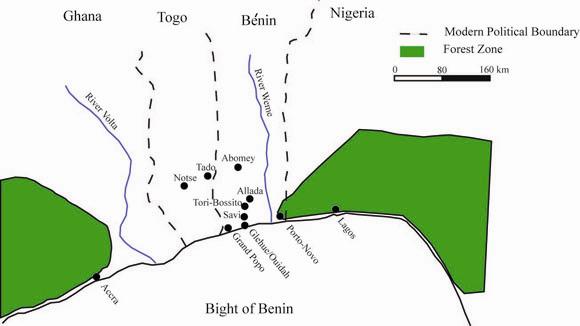 |
| Figure 1: Sites mentioned in text and major cities. |
Oral History and Systematic Survey
During an initial summer research effort in 2003, project members[3] collected oral histories from Huedan and Dahomean residents of the Savi region. In fifty-three interviews with farmers, market vendors, ritual specialists, and regional administrators little background information was gleaned on the Huedan period of occupation. Local residents related some collapsed structures, sacred forests, and religious shrines to "Huedan Kings" or "of Huedan construction." However, the vast majority of our collaborators suggested that their families entered the area after Dahomean conquest of Savi in 1727 and thus they had little background information relating to the earlier Hueda period.[4] Residents of the Savi area suggested that project members conduct interviews at the royal courts of Allada and Tori-Bossito and also with the remnants of the Huedan royal line now residing in Ouidah and Grand Popo.
Subsequent interviews in these courts produced fascinating background data on the settlement of Savi circa 1630 by groups from modern-day Togo and Nigeria, accounts of the mass flight of tens-of-thousands from the Savi region in response to Dahomean invasion and attempts to reestablish the Huedan royal line. Nevertheless, these results were similar to those in the Savi countryside in the sense that little specific information could be acquired describing the immediate region beyond Savi for the period 1670 to 1727. The vagaries of these findings required other techniques to identify sites surrounding the palace.
For a month during the summer of 2004 and two months in early 2005, project members conducted archaeological survey involving systematically placed transects. Survey methodology included six-meter-diameter surface collections at 100 m intervals along transects.[5] In total the project team conducted 54 survey transects covering 35 km and containing 407 surface collection tests. The survey efforts represent 2.6% coverage of the entire survey universe. Three hundred and seventeen (78 %) of the tests contained at least one artifact. The survey universe was so densely scattered with artifacts, particularly locally produced ceramics, that it proved impossible to distinguish "sites" using cruciforms or other techniques. However, it was possible to record deflated architectural features (e.g., courtyards with surrounding sleeping and storage structures and boundary ditches) and bracket off loci of larger architectural features. These loci were initially classified (e.g., agricultural village, smelting center, secondary administrative center) based on the size of the architectural elements, the density and richness of artifacts, and evidence of productive activity. Within the survey universe, the heaviest concentration of architectural loci forms two major axes: a very dense concentration along the modern road between Abomey and the sea and an east/west trending area which surrounds the banks of Lake Toho.
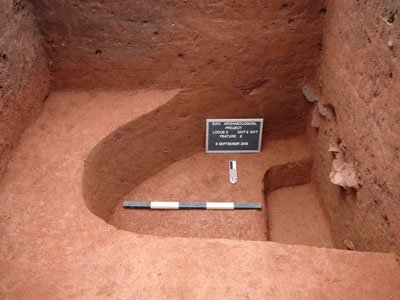 |
| Figure 2: Sample excavation unit. |
Archaeological Testing
Seven loci with temporal affiliation to Savi were chosen for excavation and further exploration. Between May and December 2005, fifty excavation units were placed throughout loci to explore architectural zones (e.g., ditches, rooms, courtyards) and spaces between structures (Figure 2). The earliest strata recorded at five loci exhibited friable coarse local ceramics and associated local stone tools (e.g., quartz, silex) distinct from and overlain by later Savi-era deposits (Figure 3). Radio carbon dates are pending, but most likely these earliest deposits represent Late Stone Age (LSA) occupation followed by iron age material and it is possible that the relation of these strata represents the shift, perhaps transition, between LSA and iron-using groups. When viewed in terms of a regional settlement pattern, the heavy concentrations of presumably LSA material near Lake Toho and the relative absence of LSA near the main North/South road[6] coupled with the density of Savi era material along this corridor suggests a shifting settlement pattern in the early Atlantic era away from aquatic resources and towards international trade. When comparing the two assemblages, there is a vast increase in the diversity and frequency of material between LSA assemblages and those for Savi-era material. Among locally produced ceramics, the ware types and vessel forms recorded in the Savi countryside are remarkably similar to those recorded by Kelly (1995: 139-57) within the palace. Likewise, distinctive local coarse earthenware ceramic decoration such as rouletting, stamping, incising, perforating, and composites of these four recovered in the palace were also recorded in the countryside sites (Figure 4).
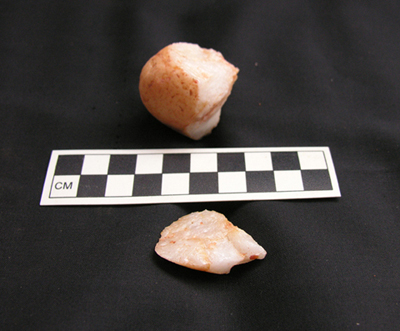 |
| Figure 3: Quartz core and reduction flake. |
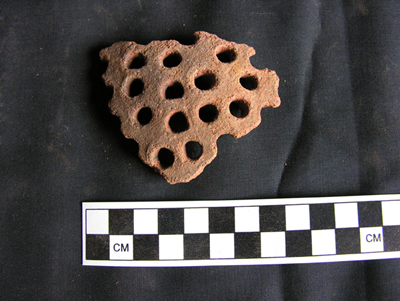 |
| Figure 4: Perforated ceramic sherd. |
A Window into Huedan Town and Countryside
Although analysis of survey and testing material is continuing, some tentative results can be offered. In the early 18th century, Savi was encircled by numerous secondary administrative centers. Both the palace and administrative centers were surrounded by agricultural villages creating a tightly nucleated settlement system.[7] The resulting mosaic countryside with the palace at its center is similar to Yoruba urban arrangements and compound layout (cf. Bascom 1944, Krapf-Askari 1969). Secondary administrative centers with immense architecture are comparable to those recorded by Kelly at Savi and suggest that outlying Huedan elites managed labor on a massive scale. Stylistic similarities of artifacts recovered in the Savi countryside and those recovered by Kelly in the palace speak to the economic and social connections between the palace, town, and countryside. Similarly, the presence of European manufactured goods in the countryside suggests that items passing through Savi found their way to the hinterland through trade, sale, or gifting. Access to European-manufactured trade items was not equal, however: Dutch trade pipes, Italian beads, hollow ware and glass items were dramatically less densely concentrated in countryside sites than those contexts recorded by Kelly in the palace (Figure 5).
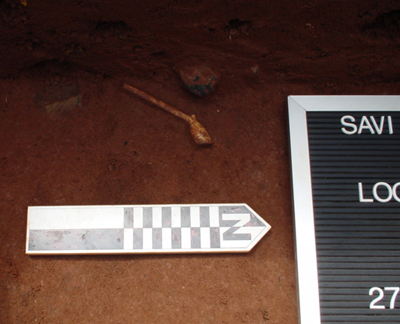 |
| Figure 5: Dutch trade pipe recovered on an 18th century living surface. |
Excavations revealed that three of the loci experienced catastrophic burning and all loci experienced some burning in the early 18th century, which suggests that Dahomean troops who are historically known to have razed the palace at Savi in early 1727 also burned a large portion of the Savi countryside. Although this moment of unmitigated Hueadan destruction (with the displacement of tens-of-thousands, thousands more killed in the war or sacrificed at Abomey, and still thousands more sold across the Atlantic) is well known to West African historians, heretofore the extent of the destruction at a local level has been unknown. Yet the wake of destruction and subsequent light resettlement present a snap-shot of Huedan material culture and social practices during the early 18th century. The excavated remains of a short locally produced metal spear head reflect martial practices (Figure 6). Likewise, at three loci, disarticulated skulls recovered in large clay vessels suggest war trophies collected during military expeditions were placed in religious contexts near residential structures (Figure 7).[8] Excavations within, or nearby, these possible religious contexts revealed non-utilitarian locally produced ceramic vessels (Figure 8) that bear a remarkable resemblance in form, decoration, and construction technique to ritual ceramics used in modern shrines in the region today (Norman 2000, Kelly and Norman 2006).
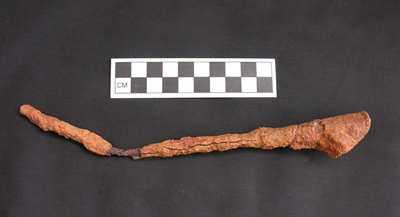 |
| Figure 6: Spear fragment. |
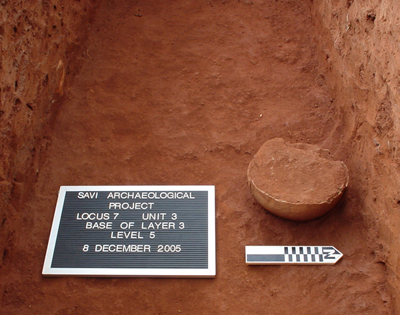 |
| Figure 7: Jar containing fragmentary skull. |
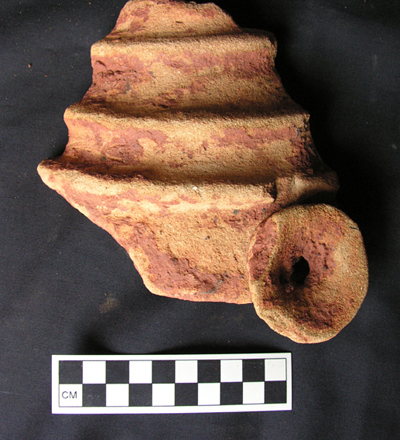 |
| Figure 8. Possible ritual vessel fragment. |
At a more mundane level, grinding and pecking stones suggest the processing of maize, local grains, and oil palm nuts. The virtual absence of hollow ceramic forms indicates that meals prepared from these staples were eaten communally from cooking vessels or served in organic containers. However, one plate fragment and one mug handle crafted from local coarse earthenware suggests that these forms were known to local potters. Nonetheless, the recovery of a bowl with the carbonized remains of a prepared meal found inside a burned structure speaks to the sudden end of household activities in the Savi countryside (Figure 9). Much work remains to expand and support these findings by refining local ceramic chronologies and broadening excavations at small-scale sites in the Savi hinterland. Though through such research, the lives of those Huedans residing outside of palaces are coming into tighter focus. With this emerging clarity, we are broadening the historic narrative to include an under-explored group that was intimately and at times forcibly drawn into the Atlantic world.
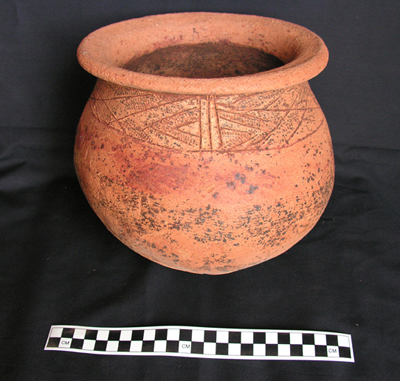 |
| Figure 9: Decorated cooking vessel. |
Museum Presentation and Supporting Agencie
In the final phase of the project (January 2006-May 2006), project members conducted intensive laboratory analysis and prepared a retrospective museum exhibit. The exhibit The Lost Communities of the Hueda Kingdom presents findings of the 2003-6 seasons and can be visited at the Ouidah Museum of History through September 2007 (Figures 10 and 11). Both the museum exhibit and the associated website: www.museeouidah.org/xweda were made possible by a special grant from the Embassy of the Netherlands to Bénin. Research efforts were supported by the University of Virginia (UVa) Center for Academic Excellence, UVa Department of Anthropology, UVa Graduate School of Arts and Sciences, Explorers Club Washington Group, the National Science Foundation, and a Fulbright-Hays (DDRA) fellowship. This project[9] would not have been possible without the generous support, encouragement, and participation by residents of Savi and Ouidah.
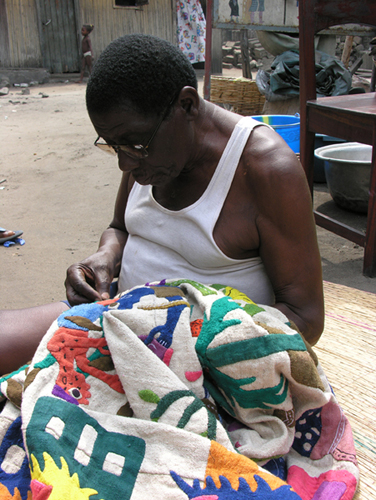 |
| Figure 10: Artist Alphonse Yemadje sewing appliqué for the museum exhibit. |
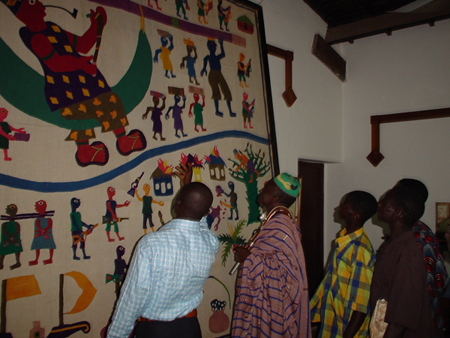 |
| Figure 11: HRH of Tori-Bossito, Kinidégbé Gbezèkpa Gbènan at the opening of the exhibit. |
Notes
1. The author, Neil Norman, is a doctoral candidate in the Department of Anthropology, University of Virginia (UVa).
2. For recent reviews of the historiography of the region see (Law 1991) and chapters in Mann and Bay (2001). Kenneth Kelly was the first to use archaeological and ethno-historic techniques to investigate Savi. For a review of previous archaeology in the Hueda region see (Kelly 2001).
3. Field and laboratory efforts were directed by the author and supported by three field schools coordinated with the University of Abomey-Calavi, 2 visiting archaeologists from the UVa, as well as 12 field technicians, 1 laboratory manager, 1 laboratory technician, and 1 translator engaged locally.
4. This finding contrast with Monroe's (2003) successful use of oral histories in the Cana and Abomey areas as a means of identifying and exploring sites in the region. A majority of Monroe's data was drawn from kings and courtly historians; however, the destruction of Savi in 1727 appears to have severed the curation of Huedan institutional histories.
5. This methodology was based on efforts by Kelly (1995: 97-101) to define the palace zone.
6. Oral history from the Savi region suggest that the modern dirt road connecting the market area in Ouidah to a junction of paved roads near Allada is the same route known from 17th-19th century historic accounts as a major trade route for captives and goods.
7. This finding supports Bosman (1705: 339) record that in the late 17th century the Savi area is so filled with towns and villages that "some are not above a Musket-shot from each other."
8. It is equally likely that these crania were from patriarchal and matriarchal figures. For a discussion of the Huedan and Dahomean practices of taking of skulls as war trophies and veneration of skulls of ancestral figures see (Law 1989).
9. My project was inspired by the research of Adria LaViolette and Jeff Fleisher. Kenneth Kelly first introduced me to the archaeology of the Hueda and continues to offer guidance and support in my current research. Jerome Handler offered insightful comments on this report.
References
Astley, Thomas
1745 A New General Collection of Voyages and Travels: Consisting of the most Esteemed Relations . . . Vol. 3. London. http:/galenet.galegroup.com/servlet/ECCO Gale Document Number CW103160831.
Bascom, William
1944 The Sociological Role of the Yoruba Cult-Group. American Anthropological Association Memoir 63.
Kelly, Kenneth
1995 Transformation and Continuity in Savi, a West African Trade Town: An Archaeological Investigation of Cultural Change on the Coast of Bénin during the Seventeenth and Eighteenth Centuries. Unpublished PhD Dissertation, Department of Anthropology, University of California, Los Angeles.
2001 Change and Continuity in Coastal Bénin. In C. R. DeCorse, (ed.), West Africa During the Atlantic Slave Trade: Archaeological Perspectives, pp. 81-100. London, Leicester University Press.
Kelly, Kenneth G and Neil L. Norman
2006 Medium Vessels and the Longue Dureé: The Endurance of Ritual Ceramics and the Archaeology of the African Diaspora. In African Re-Genesis: Confronting Social Issues in the Diaspora. J.B. Haviser and K.C. MacDonald (eds.). Pp. 223-33. London: UCL Press.
Krapf-Askari, Eva
1969 Yoruba Towns and Cities: An Enquiry into the Nature of Urban Social Phenomena. Oxford: Clarendon Press.
Law, Robin
1989 ‘My Head Belongs to the King': On the Political and Ritual Significance of Decapitation in Pre-Colonial Dahomey. Journal of African History. 30: 399-415.
1991 The Slave Coast of West Africa, 1550-1750: the Impact of the Atlantic Slave Trade on an African Society. Oxford: Clarendon Press.
2004 Ouidah: The Social History of a West African Slaving Port, 1727-1892. Athens: Ohio University Press.
Mann, Kristen and Edna Bay (eds.)
2001 Rethinking the African Diaspora: the Making of a Black Atlantic World in the Bight of Benin and Brazil. London: Frank Cass.
Monroe, J. Cameron
2003 The Dynamics of State Formation: Archaeology and Ethnohistory of PreColonial Dahomey. Unpublished PhD Dissertation. Department of Anthropology, University of California, Los Angeles.
Norman, Neil L.
2000 Through the Medium of the Vessel: An Ethnoarchaeological Investigation of Ritual Earthenwares in Southern Bénin, West Africa. Unpublished MA Thesis, Department of Anthropology, University of South Carolina.
Norman, Neil L. and Kenneth G Kelly
2004 Landscape Politics: The Serpent Ditch and the Rainbow in West Africa. American Anthropologist. 106(1): 98-110.
[Return to table of contents]
The Archaeology of Freedom and Slavery
at the President's House, Philadelphia, Pennsylvania
Ground-breaking on the President's House Site Project at Independence National Historical Park took place on March 21st, 2007. The ceremony, which was attended by students from local high schools and more than a hundred Philadelphia residents, included speeches by the Superintendent of Independence National Historical Park (Dennis Reidenbach), the Mayor of Philadelphia (John Street), the NPS Northeast Region archaeologist supervising the project (Jed Levin) and the project's Public-Outreach Cultural Heritage Specialist (Dr. Cheryl LaRoche). The excavation, which commenced immediately and will conclude in early June, is being conducted by archaeologists from URS Corporation (Research Director Dr. Warren Perry; Field Director Doug Mooney).
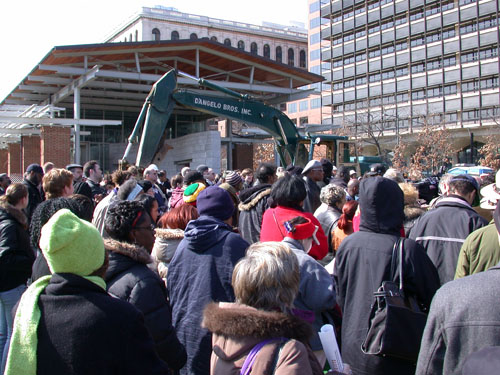 |
| Hundreds of Philadelphia residents and community activists came to Independence National Historical Park for the ground-breaking ceremony. |
The archaeological excavation is a targeted research effort focused on portions of the site of the executive mansion for the new American nation, 1790-1800. The site, adjacent to the Liberty Bell Pavilion, presents an opportunity to explore an important national story -- the birth of the United States side-by-side the institution of slavery. The site will eventually house a permanent installation designed to commemorate the President's House and all who lived there, including at least nine enslaved Africans who lived and worked in the house during George Washington's years as President.
Local African American grass roots activism, NPS policy encouraging civic engagement, the Mayor of Philadelphia, legislation introduced by members of the US Congress, and a pragmatic archaeology approach have helped move this forgotten, overlooked, and evaded national story into broader public memory. The excavation and memorial project are a joint undertaking of the City of Philadelphia and the National Park Service.
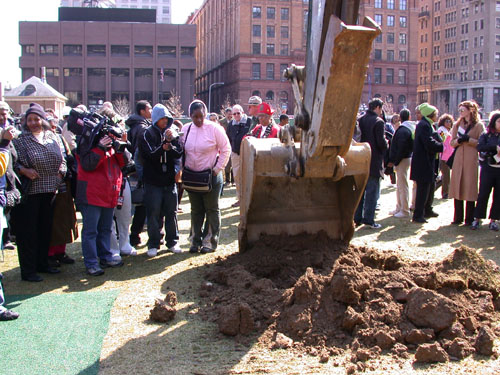 |
| Philadelphia Mayor John Street took the controls of the hydraulic excavator to officially break ground. For two hours following the ceremony the public viewed the site and took pictures of the freshly turned earth. |
A public viewing platform allows park visitors to witness the progress of the excavations. Information about the project is available on the City of Philadelphia's web site and at ushistory.org which features a regularly updated photo gallery. Independence Park's web site features information on the project and on other recent archeological projects within the park, including 2003 excavations at the home site of free African American coachman James Oronoko Dexter. A live Webcam at the archeology site is also available.
[Return to table of contents]The Politics of Culture and Diaspora Settlement in Lagos:
Ethnographic Presentation of the African Brazilian Fanti/Caretta Carnival
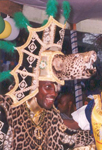
This paper offers an ethnographic presentation of the politics of Diaspora settlement in Lagos, using the popular Fanti/Caretta carnival as point of assessment. It notes that the seemingly entertaining cultural aspect of the people of Lagos as highlighted by the Fanti/Caretta carnival goes beyond mere aesthetic appreciation that largely characterizes the subject. It emphasizes some cultural and remarkable features that characterized the years which immediately followed the abolition of the slave trade and the ensuing return to Nigeria of some librated slave descendants from Brazil, where a significant proportion of the slaves from the West coast of Africa had been transported. The people, who at their return, were settled in the Campos area of the Lagos Island, had brought with them some aspects of Portuguese culture from Brazil, and largely incorporated these into the existing cultural patterns in Lagos, among which was the Caretta (later known as Fanti).
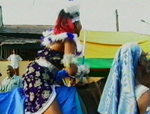
The returnees were largely believed to have experienced exclusion as they tried to integrate with the culture of the larger Lagos Island. The strains that were involved in the adjustment procedures motivated the Diaspora community to seek solace in the performance of the Caretta carnival which was a socio-cultural activity that was practiced by them during the time of slavery in Brazil. The carnival has metamorphosed over the years into a widely accepted cultural feature of the people of Lagos. Through the present ethnographic report the carnival is being presented as a profitable window through which specific aspects of the earlier indigenes versus African Brazilian inter-group relational activities in the area can be gauged. [Read this full article here in Adobe .pdf format >>>].
Dr. Simpson has also published a study entitled The Culture of Vodun and Ancestor Worship in Badagry Town (Lagos, Nigeria: Interlingua Ltd., 2001, 79pp), which is available in .pdf format on the Covenant University web site, at http://www.covenantuniversity.com/publications/index2.html.
From the author's preface: "The history of Badagry [in Lagos State, close to the border between Nigeria and the Republic of Bénin] will in no way be complete without the overall hanging impact of the slave trade era and its concomitant influence on the culture of the people of the area. The plethora of studies and research that have come up on this phenomenon in the recent past have attested to increased awareness, including international contribution like the UNESCO Slave Route Project. In this regard, the indigenous religious aspect of the people in Badagry town is being presented in this book to portray the culture of vodun and ancestor (kubito) worship as the foundational practice in the culture of the people before the dispersal of their families during the era of the slave trade. The experience of slavery itself has been identified as providing for the captives great reliance on the ideas of culture which they carried in their sub-conscious into captivity. However, those remnants left behind have maintained their culture in their natural form. . . . This book, therefore, sets out to showcase the culture of the Egun of Badagry, using the Egun of Badagry town as point of focus."
[Return to table of contents]Ned Simmons, American Slave:
The Role of Imagination in Narrative History
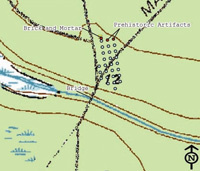
History and archaeology cover the same beat, but in very different ways. The material remains of past human activity become data when the archaeologist recognizes their significance as evidence from the past and collects and records them. Artifacts are discrete entities whose characteristics of form result wholly or partially from human activity. The archaeologist resembles the sociologist in looking for broad categories from which to issue broad generalizations. Historic archaeology has developed rather recently in the United States as a sub-set within the established discipline of professional archaeologists. In our country much of our historic archaeology has been devoted to answering questions of ethnicity. Americans have been interested, and for good reason, in exploring ethnic differences in the recovered artifacts. Ours is a country of immigrants and forced laborers, and part of the modern beliefs we share is that acceptance of ethnic differences is proper, both morally and practically. Historic archaeology accepts the challenge of whether or not racial differences are to be found in artifacts. Although it is hard to racially distinguish the owner of a cheap tin spoon found in a trash pit, archaeologists have succeeded in knitting together the probabilities inherent in the setting of the artifact.
Slave life has been viewed as dependent upon values held by the slaveholders' lives and aims. Slaves have been viewed variously as exploited, patronized, feared, subordinated, losers in a lifelong struggle with those who would benefit from slave labor. That a slave culture existed is now accepted by archaeologists. Its values differed from the slaveholders' values. Even when the two groups drew closer together in times of stress and deprivation, racial considerations continued to blind the economic elite to their many shared commonalities with their slave property.
In historical records the biography of an individual may be the activity most comparable to the preparation of an artifact for laboratory analysis. History, the written record of man's activities, frequently describes the activities of groups and classes, from which we suppose the individuals often conformed to the mores and values of the group. Biographies describe persons who have left a written record, either preserved by themselves and their immediate posterity, or gathered by contemporaries, friendly or hostile.
In historical archaeology of slave cultures in the United States, the personae (the slaves) often appear to have been nameless. Biographies of unknown persons are, practically speaking, a contradiction in terms. But among the problems to face the historical archaeologist in studying nineteenth-century slave cultures and patterns of life is the fact that often relatively few material remains can be found. The historical archaeologist is asked to produce solid evidence in regard to slave and white interaction from insufficient quantities of artifacts, features, or ecofacts. The historical archaeologist can quickly be placed in the embarrassing position (at least to the historian's eye) of reiterating archaeologically that which is already known through the written record.
This article discusses an item which unites the historical archaeologist studying slave sites with the similarly-specialized historian. It signalizes the introduction of standards which might improve the study of African American genealogy. We seek a method to unite the anomaly with the typical. Each discipline uses the techniques of the other. [Read this full article here in Adobe .pdf format >>>].
[Return to table of contents]Graduate Programs in African Diaspora Archaeology

The following compilation provides a list of graduate school programs that can provide concentration and training in African diaspora archaeology subjects. There are currently very few programs that formally offer a graduate degree specializing in this subject area, but there exist many programs that offer graduate degrees in archaeology and include faculty members who specialize in African diaspora subject areas. The list set out below was compiled based on published directories, information provided by the departments, and details sent to me by graduate students and faculty members. This list of programs and of related faculty within each program is not exhaustive. If you are aware of other graduate programs in African diaspora archaeology not listed below, or of additional details concerning those that are listed, please contact me so I can include such information in future compilations.
In addition, graduate programs in African diaspora studies or African-American studies can also be of great benefit to a graduate student seeking to specialize in related archaeological approaches. A list of such programs in African diaspora studies and African-American studies is available on the web site of the Association for Studies of Worldwide African Diasporas, at: www.aswadiaspora.org/links.html.
Ball State University
Department of Anthropology
Degrees offered: MA
Information from the school: The Master of Arts program with a major in anthropology is designed to provide students with a broad understanding of general anthropology as well as experience in a specialized area so they may pursue doctoral studies if desired. Core courses in three major subdisciplines are required, as well as a theory course. Related faculty: Mark Groover. Address: Department of Anthropology, Ball State University, Muncie, Indiana 47306-0435, USA. / Ph: (765) 285-1575 / email: mdgroover@bsu.edu / URL: www.bsu.edu/anthropology/.
College of William and Mary
Department of Anthropology
Degrees offered: MA, PhD
Information from the school: The anthropology of the past, meeting place of ethnography, historical documentation and material culture, informs the program in historical anthropology. The archaeology of colonialism, whether in a Chesapeake, New World or Atlantic context, the archaeology of the lab, whether material culture, zooarchaeology or conservation, as well as theoretical training and field applications, informs the program in archaeology. The MA and MA/PhD programs in historical archaeology and historical anthropology at the College of William and Mary offer faculty expertise and research opportunities for the study of African Diasporic communities in North America, the Caribbean, and South America. The Department's Institute for Historical Biology maintains databases on the bioarchaeology of the Diaspora. Related faculty: Michael Blakey, Marley Brown, Grey Gundaker, Richard Price, Sally Price. Address: PO Box 8795 Washington Hall, Room 103 Williamsburg, VA 23187-8795, USA. / Ph: (757) 221-1056/1055 / Fx: (757) 221-1066 / E-mail:crroex@wm.edu / URL: www.wm.edu/anthropology.
George Washington University
Department of Anthropology
Degrees offered: MA
Information from the school: Our master's program in Anthropology is designed to provide students with a comprehensive grounding in the four fields of the discipline: biological anthropology, sociocultural anthropology, archaeology, and linguistics. In addition, students may choose a formal concentration in folklife, international development, or museum training. Related faculty: John Michael Vlach, Stephen C. Lubkemann, and Pamela Cressey (head of Alexandria Public Archaeology). Address: Hortense Amsterdam House, 2110 G Street, NW, Washington, DC 20052 USA / URL: www.gwu.edu/~anth/ (G.W.U.) and oha.alexandriava.gov/archaeology/ (Alexandria Archaeology)
Illinois State University
Department of Sociology and Anthropology
Degrees offered: MA/MS
Information from school's website: The Master's of Historical Archaeology is focused specifically on the study of cultures that either have inhabited the world since the beginning of modern history or which have a long literate tradition. The multidisciplinary approach of the program allows students to take courses from an array of departments including Sociology & Anthropology, History, and Geology-Geography. Instruction focuses on the analysis, examination, and presentation of professional reports on investigation and scholarly studies detailing original research in historical archaeology. Related faculty: Charles Orser, Jr., Elizabeth Scott. Address: 332 Schroeder Hall, Campus Box 4660, Illinois State University, Normal, IL 61790-4660 USA / URL: www.soa.ilstu.edu/.
Louisiana State University
Department of Geography and Anthropology
Degrees offered: MA, PhD
Information from school's website: Located at the gateway between the Mississippi Valley and Latin America, the department offers a wide array of field and regional expertise in each of these regions. Current faculty and students conduct field research in the Mississippi Valley and American South, Central America, the Caribbean, and West Africa, as well as Asia and Europe. Related faculty: Paul Farnsworth, Rebecca Saunders, and Robb Mann. Address: 227 Howe-Russell Geoscience Complex, Baton Rouge, LA 70803-4105 USA / Ph: (225) 578-5942 / Fx: (225) 578-4420 / URL: www.ga.lsu.edu/.
San Diego State University
Department of Anthropology
Degrees offered: MA
Information from the school: When the graduate student enrolls in the Department and achieves conditional or classified graduate standing, he/she is advised by the Graduate Coordinator to develop a program of study designed to provide the breadth, depth, and specialized training necessary for a professional career in Anthropology. Related faculty: Seth Malios. Address: 5500 Campanile Dr San Diego, CA 92182-4443, USA. / Ph: (619) 594-5527 / Fx: (619) 594-1150 / E-mail:anthro@mail.sdsu.edu / URL: www-rohan.sdsu.edu/~anthro.
Sonoma State University
Department of Anthropology
Degrees offered: MA (in Cultural Resource Management)
Information from school's website: The Master of Arts in Cultural Resources Management (CRM) involves the identification, evaluation and preservation of cultural resources, as mandated by cultural resources legislation and guided by scientific standards within the planning process. The primary objective of the Master's Program in Cultural Resources Management is to produce professionals who are competent in the methods and techniques appropriate for filling cultural resources management and related positions, and who have the theoretical background necessary for research design and data collection and analysis. Related faculty: Adrian Praetzellis, Margaret Purser. Address: 1801 East Cotati Ave., Rohnert Park, CA 94928 USA / URL: www.sonoma.edu/anthropology/.
Syracuse University
Department of Anthropology
Degrees offered: MA, PhD
Information from the school: Graduate study in historical archaeology combines the theory and techniques of anthropological archaeology with the use of documentary source material and oral historical information. The department offers a strong program in historical archaeology, with particular focus on Africa and the African diaspora. However, graduate students receive holistic, four field training in anthropology. In addition, the placement of the Department within the Maxwell School of Citizenship and Public Affairs and the College of Arts and Sciences affords access to related programs such as museum studies, historic preservation, policy planning, and environmental studies. The program is unique in having several faculty with research foci on Africa and the African diaspora. Related archaeology faculty: Theresa Singleton, Christopher DeCorse, Douglas Armstrong. Related cultural anthropology faculty: John Burdick (Brazil, Latin America), Peter Castro (Africa); Deborah Pellow (Ghana). Address: 209 Maxwell Hall Syracuse, NY 13244-1090, USA / Ph: (315) 443-2200 / Fx: (315) 443-4860 / URL: www.maxwell.syr.edu/anthro/.
University of Bristol
Department of Archaeology and Anthropology
Degrees offered: MA
Information from the school: Our research is based on Prehistory, Human Evolution, Mediterranean Archaeology, Historical and Maritime Archaeology, and Cultural Anthropology. International and local fieldwork opportunities often arise from our broad geographical base, which ranges from Bristol to Zanzibar, and from the Palaeolithic to the present day. Our graduate students are actively involved in a range of archaeological and anthropological projects. Related faculty: Dan Hicks. Address: Old Baptist College, 43 Woodland Road, Clifton, Bristol BS8 1UU UK / URL: www.bris.ac.uk/archanth/.
University of California, Berkeley
Department of Anthropology
Degrees offered: MA, PhD
Information from the school: Graduate study at Berkeley is characterized by its extraordinary breadth. The department's award-winning faculty, both social cultural and archeaological, engage diverse analytic and substantive problems and work across the United States and around the world. Related faculty: Laurie Wilkie. Address: 232 Kroeber Hall Berkeley, CA 94720-3710, USA / Ph: (510) 642-3391 / Fx: (510) 643-8557 / URL: anthropology.berkeley.edu.
University of California, Los Angeles
Department of Anthropology
Degrees offered: MA, PhD
Information from the school: Though M.A.-level students specialize in the area of their choice, they are expected to have a basic understanding of all four fields in anthropology (archaeology, biological, sociocultural, and linguistic). A series of "core courses" are offered for those who lack background in one or more fields. In addition to course work, a thesis, based on original research, is expected of all M.A. students to demonstrate their ability to generate and analyze data. Students entering with a master's degree in any field need not repeat this degree, but a basic knowledge of the four fields, as well as competence in a foreign language, is expected and required before beginning doctoral work. At the doctoral level, students specialize more on their particular area(s) of interest than in one of the four subfields. Courses and research are tailored to personal interests and goals in consultation with faculty advisors. The doctoral dissertation is based on original research, typically involving fieldwork. Related faculty: Merrick Posnansky (emeritus). Address: 341 Haines Hall, Box 951553, Los Angeles, CA 90095-1553, USA / Ph: (310) 825-2055 / Fx: (310) 206-7833 / URL: www.anthro.ucla.edu.
University of Chicago
Department of Anthropology
Degrees offered: MA, PhD
Information from the school: The Department of Anthropology at the University of Chicago offers a doctoral program with a concentration in archaeology, sociocultural, or linguistic anthropology. Although an M.A. degree is earned during progress towards the Ph.D., no one is admitted to the Department solely to seek the M.A. Related faculty: Shannon Lee Dawdy (U.S., Cuba, Mexico; historical archaeology), Michael Dietler (Kenya, ethnoarchaeology), Manuela DaCunha (Brazil), Stephan Palmie (Cuba), Kesha Fikes (Portugal, Cape Verde), Jean Comaroff and John Comaroff (South Africa). Address: 1126 East 59th Street, Chicago, IL 60637 USA / URL: anthropology.uchicago.edu/.
University of Florida
Department of Anthropology
Degrees offered: MA, PhD
Information from the school: Anthropologists at the University of Florida carry out research in Africa, Latin America and the Carribbean, North America, Asia, and Europe. Our teaching program, at both the graduate and undergraduate levels and in all fields of the discipline, reflects a strong commitment to a cross-cultural, comparative perspective. We have continuing relationships with universities, research centers and institutes, government bureaus, non-governmental institutions, and development agencies in Latin America, the Caribbean, sub-Saharan Africa, and Asia. Related faculty: James Davidson and Peter Schmidt. Address: PO 117305, Gainesville, FL 32611, USA / Ph: (352) 392-2253 / Fx: (352) 392-6929 / URL: www.anthro.ufl.edu.
University of Houston
Department of Anthropology
Degrees offered: MA
Information from the school: The programs of the Department of Anthropology focus on archaeology and ethnology as specialized areas of study. A diverse curriculum provides courses in the major subfields of ethnology, archaeology, linguistics, and physical anthropology as well as in the study of important world regions, such as the United States, North America, Latin America, and Africa. Related faculty: Kenneth Brown. Address: 233 McElhinney, Houston, TX 77204-5020, USA / Ph: (713) 743-3780 / Fx: (713) 743-4287 / E-mail:edmiller@mail.uh.edu / URL: www.uh.edu.
University of Idaho
Department of Sociology, Anthropology, and Justice Studies
Degrees offered: MA
Information from school's website: The University of Idaho's Department of Sociology/Anthropology/Justice Studies offers a Master of Arts degree in Anthropology. This program includes class work, seminars, directed studies, independent research, a thesis, and a combined final oral exam and thesis defense. The curriculum provides sound training in general anthropology, archaeology, physical anthropology, and ethnology. Department research specialities include historical archaeology; prehistoric Northwest archaeology; Plateau Indian ethnography; human evolution; and indigenous peoples of South America. Related faculty: Mark Warner. Address: Phinney Hall Room 101, Moscow, Idaho 83844-1110 USA / URL: www.class.uidaho.edu/soc_anthro/.
University of Illinois, Urbana-Champaign
Department of Anthropology
Degrees offered: MA, PhD
Information from the school: Our program offers M.A. and Ph.D. degrees, including a new M.A. track concentrating on Cultural Heritage and Landscape studies, offered in conjunction with the Department of Landscape Architecture. Our graduate program provides students with in-depth training and education in a range of theoretical and methodological approaches to archaeological investigations. Graduate research and coursework opportunities are also available through the University's African American Studies and Research Program and the Center for African Studies. Related faculty: Christopher Fennell, Helaine Silverman, Marc Perry, Rebecca Ginsburg, Arlene Torres, and Norman Whitten (emeritus). Address: 109 Davenport Hall, 607 S Mathews Ave, Urbana, IL 61801, USA / Ph: (217) 333-3616 / Fx: (217) 244-3490 / E-mail:anthro@uiuc.edu / URL: www.anthro.uiuc.edu.
University of Maryland
Department of Anthropology
Degrees offered: MAA, PhD
Information from the school: The University of Maryland's Master of Applied Anthropology (MAA) is an innovative, two-year professional degree designed for those students interested in the practice and application of anthropology in careers outside of academia. Program emphasis is on the utilization and mediation of anthropological knowledge in practical settings. Among the courses offered are studies in archaeology, biology, and culture of the transatlantic African Diaspora. Skills are developed through internships and enhanced by working with professionals in related and complementary fields.
The Department of Anthropology now offers a Ph.D. The new program opened in 2007 and the first doctoral students in anthropology have been accepted. Training is offered to historical archaeologists who wish to combine anthropological orientations with the practical application of archaeology in work settings. Opportunities exist with Archaeology in Annapolis, the National Park Service, many diasporic locations within the United States, and in the laboratories within the department. The University of Maryland, College Park has wide-ranging and interdisciplinary scholars and opportunities throughout the fields concentrating in the African diaspora.
Related faculty: Mark Leone, Paul Shackel, Fatimah Jackson, and Tony L. Whitehead. Address: 1111 Woods Hall, College Park, MD 20742-7415, USA / Ph: (301) 405-1423 / Fx: (301) 314-8305 / E-mail:anthgrad@deans.umd.edu / URL: www.bsos.umd.edu/anth.
University of Massachusetts, Amherst
Department of Anthropology
Degrees offered: MA, PhD
Information from school's website: The graduate program in anthropology enables students to become fully competent anthropologists. Robert Paynter conducts research at the W.E.B. Du Bois Boyhood Homesite. This work is greatly facilitated by access to and staff support for Du Bois's Papers that are in the Special Collections and Archives of the W.E.B. Du Bois Library at UMass Amherst. Enoch Page and Amanda Walker Johnson, colleagues in the Anthropology Department, share research interests in related aspects of the African Diaspora. Faculty and students in the W.E.B. Du Bois Department of Afro American Studies and in the Public History Program of the History Department also share interests in African Diaporic research and presenting it to this country's many publics. Related faculty: Robert Paynter, Enoch Page, and Amanda Walker Johnson. Address: 215 Machmer Hall, Amherst, MA 01003 USA / URL: www.umass.edu/anthro/.
University of Massachusetts, Boston
Department of Anthropology
Degrees offered: MA
Information from school's website: Unlike many other programs in the U.S. that offer M.A. degrees in archaeology, the UMass Boston program is currently devoted solely to historical archaeology and its integration with anthropology and history. The sharpness of focus yet depth of coverage is made possible by the significant number of historical archaeologists and associated colleagues in the program's primary academic departments and affiliated research center, and their joint commitment to a significant set of critical themes in historical archaeology. Related faculty: Stephen Mrozowski. Address: Department of Anthropology, University of Massachusetts-Boston, Boston, MA 02125-3393 USA / Ph: 617-287-6854 / Fx: 617-287-6857/ URL: www.umb.edu/academics/departments/anthropology/.
University of Montana
Department of Anthropology
Degrees offered: MA, PhD
Information from the school: The Cultural Heritage Option is a way to earn the MA degree in anthropology while focusing on methods and theories related to preserving the culture, heritage, and diversity of all peoples. It is designed to produce professionals in the many areas of culture heritage preservation who are firmly grounded in the fundamentals of anthropology. Related faculty: Kelly J. Dixon and Gregory Campbell. Address: Social Science Bldg 235, 32 Campus Drive Missoula, MT 59812, USA / Ph: (406) 243-2693 / Fx: (406) 243-4918 / E-mail:linda.mclean@umontana.edu / URL: www.umt.edu/anthro.
University of Pennsylvania
Department of Anthropology
Degrees offered: MA, PhD
Information from school's website: Our department is unique in that it offers a 4-field approach, providing breadth of training. The core courses for the Masters (MSc) and PhD programs provide an in-depth introduction to Anthropology as a whole. Because of the broad education offered, graduates and advanced students of the program would be qualified to teach in areas beyond their own specialty, resulting in multiple teaching opportunities. Related faculty: Robert Schuyler. Address: University Museum Rm. 323, 3260 South Street, Philadelphia, PA 19104-6398 USA / URL: www.sas.upenn.edu/anthro/.
University of South Carolina
Department of Anthropology
Degrees offered: MA, PhD
Information from the school: The Department offers the M.A. and, as of 2005, the Ph.D. in Anthropology. Our program offers instruction in the four traditional sub-fields of anthropology: archaeology, cultural anthropology, linguistic anthropology, and physical/biological anthropology. In this we are unusual. As of 1993, the American Anthropological Association had noted that only 28% of all departments had faculty in all of the four traditional sub-fields. While students are asked to specialize in one of these fields, we particularly seek students who wish to cross the boundaries between fields and combine them in their graduate work. Particular areas are African American historical archaeology (Kelly, Weik, and Clement), African prehistoric archaeology and ethnoarchaeology (Casey), African historical archaeology (Kelly), ethnobotany (Wagner) and Eastern North America (Wagner and Cobb), and bioarchaeology in Mexico (Cahue). The South Carolina Institute of Archaeology and Anthropology also has several archaeologists working on prehistoric and historic archaeology of the Southeast and a very large collection of materials from the state. Related faculty: Kenneth Kelly, Terrance Weik, Joanna Casey, Gail Wagner, Charles Cobb (Director, SCIAA), Christopher Clement (SCIAA) and Leland Ferguson (emeritus). Address: 1512 Pendleton Street, Hamilton College Room 317, Columbia, SC 29208, USA / Ph: (803) 777-6500 / Fx: (803) 777-0259 / E-mail: anthroinfo@gwm.sc.edu / URL: www.cas.sc.edu/ANTH/.
University of Southern Mississippi
Department of Anthropology and Sociology
Degrees offered: MA
Information from the school: The graduate program emphasizes exposure to the four fields of anthropology as a means of preparing for further graduate study, applying anthropological principles in the public service or government sectors, or teaching at the undergraduate level. At the same time we expect students to develop an in-depth grounding in their subfield of interest, from theoretical, methodological, and practice standpoints. We also encourage development of a personal research interest as quickly as possible, ultimately expressed as thesis research. We encourage students to explore topics about which the faculty can provide useful input either through coursework, directed reading, or personal expertise. Related faculty: Amy L. Young. Address: 118 College Dr #5074, Hattiesburg, MS 39406-0001, USA / Ph: (601) 266-4306 / Fx: (601) 266-6373 / E-mail:antsoc@usm.edu / URL: www.usm.edu/antsoc.
University of Texas, Austin
Department of Anthropology
Degrees offered: MA, PhD
Information from the school: Archaeology at the University of Texas reflects the breadth of specialization of its faculty, and its strong links with other disciplines. The program enjoys strong ties with Geography, Classics, Latin American Studies, Asian Studies, Social, Cultural, Folklore and Public Culture, Linguistics, and Physical Anthropology. A strong and active group of graduate students, the presence of the Texas Archeological Research Lab, major CRM firms, and offices in State Government make Austin's community of archaeologists and related scholars exceptionally large and diverse. Graduate programs and tracks within Anthropology include the African diaspora graduate program, Borderlands, and Activist Anthropology. Related faculty in Archaeology and African Diaspora studies: Maria Franklin (historical archaeology, North America), Samuel Wilson (prehistory and ethnohistory, Caribbean), James Denbow (prehistory, Africa), Edmund Gordon (social anthropology, Latin America), Jafari Allen (social anthropology and folklore/public culture, Caribbean and North America), Joao Vargas (social anthropology, Brazil and North America), Jemima Pierre (social anthropology, West Africa and North America). Address: Department of Anthropology, 1 University Station C3200, Austin, TX 78712-0303, USA / Ph: (512) 471-4206 / Fx: (512) 471-6535 / for information on the anthropology graduate program and admissions contact Andi Shively at ashively@mail.utexas.edu / URL: www.utexas.edu/cola/depts/anthropology/.
University of Virginia
Department of Anthropology
Degrees offered: MA, PhD
Information from the school: The archaeology section of the department includes eight faculty whose research and teaching examine anthropological questions through the study of past societies. The interests of the faculty and graduate students span the Old and New Worlds -- specifically North America, South America, Africa, and the Near East -- and the prehistoric through historic periods. In each of these areas we emphasize the integration of anthropological theory with archaeological field methods, artifact analysis, and analytical approaches. Related faculty: Jeffrey Hantman, Adria LaViolette, Dell Upton, Fraser Neiman, and Elizabeth Arkush. Address: PO Box 400120, Charlottesville, VA 22904-4120, USA / Ph: (434) 924-7044 / Fx: (434) 924-1350 / URL: www.virginia.edu/~anthro/.
[Return to table of contents]
Nate Harrison Archaeology Project

Seth Mallios and his colleagues at San Diego State University have now completed a number of field seasons on the Nate Harrison Archaeology Project, and present data and interpretation on an expanding internet site, available at www-rohan.sdsu.edu/~histarch/.
A description of the project from the web site:
"Nate Harrison is one of San Diego County's legendary pioneers. Fables abound regarding this former enslaved African-American from the South who lived high upon the west slope of Palomar Mountain into the early 1900s. There are numerous quaint tales of his frontier life. For example, this rugged yet compassionate mountain man allegedly added lizards to his coffee grinds for extra flavor, made batches of homemade mountain lion jerky, and met every visitor with a warm smile. . . . Historical archaeology has the potential to evaluate, scrutinize, broaden, and deepen insights into Nate Harrison's life and legend. This report presents findings from the inaugural 2004 San Diego State University field excavation season at the Nate Harrison site. The three-week field school successfully located the remains of Harrison's cabin and uncovered over 6,100 artifacts that date to Harrison's late 19th-century and early 20th-century occupation at Palomar Mountain. Although there had been previous pot-hunting on the site, the 2004 excavations marked the first scientific archaeology on the property."
[Return to table of contents]
New Museum
A new International Slavery Museum will open in August, 2007, to mark the 200th anniversary of the abolition of the slave trade in Britain. Located in Liverpool, England, this museum will present interactive exhibits and online resources to celebrate and preserve the history and spirit of those who endured and overcame slavery. For more information, see the museum web site at http://www.liverpoolmuseums.org.uk/ism/.
Expanded Mission for School of American Research

"In 2007, the School of American Research celebrates its 100-year anniversary with an expanded mission, special events, and a new name -- the School for Advanced Research on the Human Experience (SAR). Founded in 1907 by archaeologist Edgar Lee Hewett, SAR has become a unique center for advanced study in anthropology and the indigenous arts. As SAR enters its second century, it is embracing an expanded mission to promote a broader body of anthropologically informed scholarship in the humanities and social sciences and to reach a global constituency of scholars, policy-makers, and members of the public. New initiatives that reflect SAR's expanded goals include the launch of a Global Indigenous Politics series published by the renowned SAR Press, an enhanced Summer Scholar program that now includes modest stipends, the ability to now accommodate more international scholars in SAR programs, and a new Douglas W. Schwartz Advanced Seminar in Anthropological Archaeology. More information on all of SAR's program, as well as information on special Centennial events, can be found at http://www.sarweb.org/."
The SAR welcomes proposals addressing African diaspora subjects.
[Return to table of contents]New Book
By Abi Alabo Derefaka.
Onyoma Research Publications, Nigeria; North American Distribution by Michigan State University Press and African Books Collective, Oxford; Paper, 330 pp., December 2006.
Description from the Publisher:
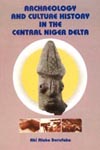
Abi Alabo Derefaka is Senior Lecturer in Archaeology at the University of Port Harcourt, Nigeria. This book is a new contribution to existing archaeological research relevant to the cultural and anthropological history of Central Ijöland, situated in the Central Niger Delta. It draws primarily on oral traditions, local and internal histories in the reconstruction of the past. By tracing patterns of migration and dispersals within and from the region and examining material cultural items, the author attempts to reconstruct phases, settlements and ways of life. The work considers both the saltwater mangrove swamps sub-zone in the eastern region, and the freshwater swamp and forest sub-zone of the central Delta region. It sets out a reliable chronology of this sub-region. Finally, it highlights the cultural relationships and differences between the Ijö and other communities of the Eastern Delta.
New Book
A Social History of Afro-Curaçaoans, 1863-1917
By Rose Mary Allen.
SWP Publishers, Amsterdam; ISBN: 9789066658516, 304 pp., Eerste druk 2007.
Description from the Publisher:
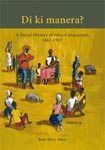
Di ki manera? focuses on the dynamics of Afro-Curaçaoan social life from 1863 until 1917, with special emphasis on the close relationship between culture and power in daily life. This study explores the ways the formerly enslaved Curaçaoans contested the asymmetric power relations dominated by the colonial state, the former slave-owners and the Roman Catholic Church. In the face of continuing racial, social and economic inequality, Afro-Curaçaoans carved out their own social practices, political and spiritual beliefs. The use of oral history has been central in this study, enabling the author to present and analyze long forgotten or hidden information about the Afro-Curaçaoan community. The speakers expose, in their own words, the diversity and complexity of their social reality. The combination of various types of written and oral data, coupled to extensive literature research, has enabled the author to attain a better understanding of cultural dynamics among the Afro-Curaçaoan population. Rose Mary Allen is a Curaçaoan cultural anthropologist with a long-standing research experience in several islands of the Netherlands Antilles, in particular among the descendants of enslaved Africans. The present study is her doctoral dissertation, defended at Utrecht University.
New Book
Edited by S. Ademola Ajayi.
Published by the Ibadan Cultural Studies Group, Nigeria; North American Distribution by Michigan State University Press and African Books Collective, Oxford; Paper, 452 pp., ISBN 9783545450, 9789783545458, April 2007.
Description from the Publisher:
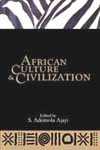
From interdisciplinary and continental perspectives, this volume explores elements of African culture and ideas, indigenous and modern, and how they have evolved through the ages. It considers areas such as education; cross-culturalism; the relationship between African, Arabic and Egyptian civilizations; traditions of philosophy; music, the performing arts and literature; language; gender; and the impact of colonialism and pan-Africanism. S. Ademola Ajayi is a senior lecturer in history at the University of Ibadan.
[Return to table of contents]Call for Papers
International Conference on the
Benin/Edo Diaspora
Benin City, Nigeria, July 25-27, 2007.
Theme: Harnessing the Benin-Edo Diaspora for Development. Great Benin in South-central Nigeria was one of the earliest forest Kingdoms founded in Africa by the Edo speaking people. Outside the Edo heartland, the Kingdom spawned a diaspora which played a vital role in establishing and consolidating Benin Kingdom's influence and spreading Edo culture. This diaspora's link with Benin was terminated by colonial fiat and resulted in the disconnection between Benin and the diaspora,increasing loss of knowledge of the state of existence of the diaspora and loss of the mutual benefits of the relationship. The Institute for Benin Studies is organizing an international conference in July 2007 to address these problems of the state of the Benin-Edo Diaspora and reawaken the pride of the Diaspora in their Benin Edo identity.
Sub-themes include: historiography of Benin/Edo Diaspora and relations with Benin; origins of Benin/Edo Diaspora; Edo Diaspora in Yoruba land- Akure, Ekiti, Owo, Akoko, Ilorin,Ikale, Ijesha and Eko-Lagos; the Edo ne Akure in Benin and Yoruba Politics, Economy and Society; Edo Diaspora in Igbo land and the Niger Delta; Benin Kingdom, the Trans-Atlantic Slave Trade and Edo Diaspora and influences in Sao Tome and Principe, West Africa and the Americas; the impact of Colonialism on the Benin/Edo Diaspora; the new Benin/Edo Diaspora in a globalized World-Europe, Americas and Asia; the future of Benin and the role of the Benin/Edo Diaspora.
For additional information, contact: Secretary, Institute for Benin Studies, 18 Ezoti Street, Off Airport Road, P.O. Box 12708, Benin City, Edo State, Nigeria; email insbenst@hotmail.com or ibs@ibs.kabissa.org.
[Return to table of contents]Call for Papers
Atlantic Slavery in the Age of Revolution, 1760-1868
University of Leeds, December 12-14, 2007.
The Institute for Colonial and Postcolonial Studies and the School of Modern Languages and Cultures of the University of Leeds invite scholars interested in the history of slavery in the Atlantic world in the Age of Revolution to participate of a two-day conference whose purpose will be to stimulate a discussion of the political processes of slavery, abolition and empire that at once shaped and were shaped by the Atlantic world. Our goal would be to examine the articulations of the slavery, anti-slavery, and slave resistance with the politics of empire, anti-colonial nationalism, state formation, interstate relations and international law and their cumulative effects throughout the Atlantic world over a long historical period.
By these means we seek to promote a discussion of the political constitution of the Atlantic as an historical space in contrast to soliciting monographic contributions that are inserted in the Atlantic. Rather than simply a commemorative conference, we intend to contextualise and reinterpret British anti-slavery and slave resistance throughout the Atlantic in terms of their Atlantic causes and consequences.
We welcome paper and panel proposals from both established and junior scholars. Please send your proposals by email either to Dr Manuel Barcia, m.barcia@leeds.ac.uk or Professor Dale Tomich, dtomich@binghamton.edu. Deadline for proposals: 20 September 2007. For more details visit our webpage at: http://www.leeds.ac.uk/icps/.
[Return to table of contents]Call for Papers
The History of Racism, Slavery and their Aftermath:
Recognizing the 200th Anniversary
of the Abolition of the Atlantic Slave Trade.
Great Lakes History Conference,
Grand Rapids, Michigan, October 26-27, 2007.
The 32nd annual Great Lakes History Conference, sponsored by Grand Valley State University, will be held in Grand Rapids, Michigan on October 26th and 27th, 2007. All fields of history as well as other disciplines are invited to submit proposals related to this year's theme: "The History of Racism, Slavery and its Aftermath: Recognizing the 200th Anniversary of the Abolition of the Atlantic Slave Trade." We invite scholars from a wide range of fields and disciplines to exchange ideas and research on this topic.
We are pleased to announce presentations by two distinguished keynote speakers. Our speakers will include Prof. Wilma King from the University of Missouri. Prof. King is an award-winning historian specializing in the history of African-American women, youth and childhood. Her books include Stolen Childhood: Slave Youth in Nineteenth Century America and African-American Childhoods in Historical Perspective. In addition, we are pleased to announce David Brion Davis from Yale University will provide a keynote. Prof. Davis is one of the leading scholars on the history of the slave trade. His extensive publications include In the Image of God: Religion, Moral Values and Our Heritage of Slavery and Inhuman Bondage: The Rise and Fall of Slavery in the New World, published last year. Prof. Davis is also a frequent contributor to the New York Review of Books.
We welcome papers and arranged panels addressing this year's topic. We encourage comparative work across regions and chronological boundaries. The conference will be organized around themes that have dominated recent scholarship. Papers are encouraged to touch on, but are not limited to, the following:
The origins of the Atlantic slave trade
The abolition of the slave trade
Abolitionist movements in Europe and the Americas
History of the Middle Passage
History of racism in Europe and the Americas
Comparative perspectives on slavery in the Americas, Caribbean
Social, cultural, political and economic perspectives on slavery
Slave culture and history of everyday life
Slavery and the US Civil War
Comparative histories of racism and genocide (e.g. slave labor and genocide during World War II in Europe and Asia)
Slavery in the 20th century (sexual and economic exploitation)
Legacies of slavery and racism (social, political, economic, cultural-psychological)
Perspectives on reparations debates
Representations of slavery and racism in film
Slavery and racism in literature.
If you are interested in presenting a paper, please send an abstract of approximately 200 words and a curriculum vitae by June 25, 2007. Please include your address, email, and phone number. Those interested in commenting on a session should send a CV and indicate areas of expertise. Papers must take no longer than 30 minutes in a 2-paper session or 20 minutes in a 3-paper session. Sessions will last 90 minutes.
Conference headquarters will be at the L.V. Eberhard Center of Grand Valley State University in downtown Grand Rapids. Hotel accommodations will be available at the Days Inn of Grand Rapids, which is across the street from the Eberhard Center. The conference is within easy walking distance of museums and restaurants. Grand Rapids is served by most major and regional airlines. Please address all inquiries and abstracts to: Jason Crouthamel or Craig Benjamin, crouthaj@gvsu.edu benjamic@gvsu.edu, Dept. of History, Grand Valley State University, 1018 MAK, 1 Campus Drive, Allendale, MI 49401, (616) 331-2931.
[Return to table of contents]Editor's Note on Book Reviews
John McCarthy is coordinating book reviews to be written for this Newsletter, and he has received review copies of a number of books from presses that he can supply to individuals who agree to write a review of such recent publications. If you, or someone you know, would be interested in book review assignments for the African Diaspora Archaeology Newsletter, please drop John a note, at strongjohn10856@gmail.com. A reviewer receives a free copy of the book.
I also will occasionally publish selected book reviews in this Newsletter from H-Net, the Humanities and Social Sciences Online service, which makes such reviews available for reproduction for educational purposes. Other reviews are available on the H-Net Reviews web site. -- Chris Fennell
[Return to table of contents]Book Review

David Brion Davis. Inhuman Bondage: The Rise and Fall of Slavery in the New World. New York: Oxford University Press, 2006. 440 pp., illustrations, 8 pp. halftone plates, 8 maps. $30, ISBN 0195140737.
Reviewed for the African Diaspora Archaeology Newsletter by Anya Zilberstein, Massachusetts Institute of Technology.
There are now several excellent big histories of Atlantic slavery, including Robin Blackburn's, The Making of New World Slavery: From the Baroque to the Modern, 1492-1800 (1997), Seymour Drescher's, From Slavery to Freedom: Comparative Studies in the Rise and Fall of Atlantic Slavery (1999), and David Eltis's, The Rise of African Slavery in the Americas (2000), to name just a few. David Brion Davis's latest book is bigger. Davis, Sterling Professor of History Emeritus at Yale, has long been one of the preeminent historians of American slavery. The Atlantic is the geographical center of Inhuman Bondage; the development of the slave trade and plantation economies, racial slavery, and emancipation are its primary themes. But Davis situates New World slavery in a broader international context and locates the origins of its core problems and legacies in cultural developments over the long term. Inhuman Bondage considers the ownership of people as it has been practiced and experienced in societies as diverse as ancient Sumeria and medieval Scandinavia to present-day sweatshops and the traffic in sex slaves. Davis does not offer a single, sweeping argument to encompass this immense scope. Rather, Inhuman Bondage is a deeply engaging and elegantly written survey of New World slavery and antislavery in comparative perspective.
The key to the book's title is Davis's proposition that 'animalization' -- reducing people to salable beasts of burden -- is a crucial element of human bondage. Adding to Orlando Patterson's definition of slavery as a state of extreme personal domination, natal alienation, and isolation from social networks, Davis writes that the enslavement of people is analogous to the management of domesticated animals: masters have regarded their human chattel much as they have their livestock and pets (pp. 30-35). This attempt to bestialize humans was explicit in the common ancient Greek term for slave -- andrapodon or, man-footed creature. As an African-American former slave remarked in the nineteenth century, "plantation owner[s] thought no more of selling a man away from his wife, or a mother away from her children, than of sending a cow or horse out of the state" (p. 201).
Davis calls the "fundamental paradox of slavery" the fact that, despite such degrading definitions, historically slaves found ways to retain their human dignity and resist total domination by their masters, through cultural adaptations, the formation of extended kin or social networks, and individual or collective rebellions. Yet the aims and consequences of slave rebellions were often localized and worked against radicalizing antislavery ideology among free blacks and white sympathizers (this point is especially subtly demonstrated in a chapter comparing slave conspiracies and uprisings in the nineteenth-century U.S. South and the British Caribbean). Instead, Davis emphasizes the importance of changes in moral attitudes, the ideological impact of revolutionary rhetorics of liberty and human equality, and the mixed success of gradual emancipations. He argues that, ultimately, the legal and institutional changes in New World slavery in the nineteenth century were mobilized by national and international abolitionist movements rather than destabilized by economic forces or by agitation from below.
The book opens with the multinational debate in the 1830s and '40s over the legal status of the Cuban ship La Amistad and its passengers, followed by a chapter on non-racial and apparently more moderate forms of slavery, which draws on examples from Antiquity and pre-contact Brazil. In Chapter 3, "The Origins of Anti-black Racism in the New World," Davis discusses the association of swarthy skin with lowly status in the medieval Eastern European and Mediterranean slave trades and argues that by the late fifteenth century slavery had already taken on deep racial connotations, a tendency exacerbated by the expansion of the African Atlantic slave trade in the early modern period. He also attends to historical Jewish, Christian, and Muslim interpretations of the biblical Curse of Ham legend and its enduring, if misconceived, authority as a justification for racial slavery and anti-black racism.
The majority of Inhuman Bondage focuses on the rise of slavery in the Atlantic world, particularly in the colonial and nineteenth century southern United States (to which Davis devotes two chapters). The 'fall' of slavery is treated in chapters on British and American abolitionism, the politics and impact of the American, French, and Haitian revolutions, and the radicalism of emancipation policy in the American Civil War. While much of the story regarding slave work culture, plantation life, or the economics of staple crop production and trade will be familiar to specialists, Davis's originality and exceptional breadth as a historian is revealed in his provocative analogies and his choice of uncommon anecdotes. He identifies aspects of work discipline in early modern sugar plantations, for example, as precursors to Frederick Winslow Taylor's principles of 'scientific management' for industrial factories. Readers who tend to think of the Atlantic crossings of Africans as unidirectional will be intrigued by the case of freed slaves who migrated to Liberia in the 1780s and maintained a correspondence with their former white masters in Virginia.
Readers of this newsletter may note that archaeology and material culture minimally inform Davis's narrative or arguments. Perhaps the only obvious reference to work by archaeologists is the 1992 discovery of the African burial ground in Manhattan as evidence for the surprisingly substantial presence of African-American slaves in colonial New York (and the North generally). Indeed, this is a book that emphasizes the social, economic, and political aspects of New World slavery, focusing on continuities in the moral and ideological underpinnings of slavers throughout Western history and the transformative power of reform movements.
But Davis's intellectual work in integrating debates across a broad range of disciplines provides a productive framework for further dialogues. By tracing the legacies of ancient, classical, and biblical traditions in New World slavery, for example, Inhuman Bondage shows convergences between the concerns of archeologists across numerous subfields (a point implicit in the book's useful maps and well-chosen illustrations. Its long-term, world history perspective also suggests points of connection and comparison in diasporic slave communities: Davis notes, for example, that white slaves from Eastern Europe were sent to sugar plantations in the Americas in the late sixteenth and seventeenth centuries. In addition, scholars of material culture will be engaged by Davis's exhortation to see the mutual shaping of African-American and white ethnic cultures, rather than seeking to isolate the supposedly distinctive features of each (see especially Chapter 10).
The book's organization is somewhat disjointed, likely because it is not the product of new primary research, but a composite of lectures from Davis's university courses and previously published work, revised and updated to include recent and emerging scholarship in a range of relevant fields. This variety will not be a concern for teachers seeking to situate the archeology of Atlantic slavery in a world historical context, for whom Inhuman Bondage should prove indispensable.
[Return to table of contents]Book Review
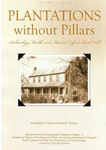
Melanie A. Cabak and Mark D. Groover. (2004). Plantations without Pillars: Archaeology, Wealth and Material Life at Bush Hill. (Volume I). Savannah River Archaeological Research Program, South Carolina Institute of Archaeology and Anthropology: University of South Carolina.
Reviewed for the African Diaspora Archaeology Newsletter by Jacqueline Pitts, an Independent Scholar.
Plantations without Pillars: Archaeology, Wealth and Material Life at Bush Hill, primarily serves as an archaeological report on the Bush Hill plantation located in Aiken County, South Carolina, near the Savannah River. The research conducted by Melanie Cabak and Mark Grover made Bush Hill the first archaeologically investigated antebellum plantation site in the middle Savannah River valley. The authors used Bush Hill as a case study to reconstruct the standard of living of southern planters in the region. The research also provided an opportunity for Cabak and Grover to assert their arguments, develop a research design that includes a typology of plantations, test their hypothesis, and interpret data.
Cabak and Grover developed a plantation typology that is a synthesis of research designs from other disciplines. Time periods, crop regimes, and geography are the foundation of the typology and were used to explore other variables. Although the typology is dispersed throughout the text identifiable by sub-headings, the authors also provide a dedicated list within the text.
The underlying premise of Plantations without Pillars was to illustrate that plantations and the materiality of plantation life were not monolithic for planters and possibly not for enslaved laborers, along with dispelling the myth that all or most planters lived an existence reminiscent of the opulence depicted in Gone with the Wind.
The monograph informs readers that the site was occupied by the Bush family from circa 1807-1920, and owned by the Bush family from circa 1790 until 1951 when the property was purchased by the United States Department of Energy. Excavations were conducted on the site in 1996 and 1999, prior to the government's plans for further development in the area, which impacted the area of the main complex of the former plantation.
The family's oral history identifies a 17th century individual named John Bush as the ancestor who migrated to Virginia from Bristol, England. The authors tell us that the historical record does not confirm this, but that John Bush was likely a relative. Theoretically, I think we may accept the family's oral history since these traditions tend to contain some accuracy and historical studies do record a migration and active economic connection between the South Western part of England (which includes Bristol) and the Carolinas during the time period.
Historical documents identify Bush Hill as a 3,000 acre cotton plantation by 1850 with the family occupying a two-story, central-hall "I" house on the site for over 100 years. During the antebellum period in the Savannah River region the Bushes were among the area's socially prominent and wealthy families. However, the archaeological evidence indicates that they lived below their economic means and were voracious consumers of inexpensive goods.
Returning to the underlying premise of the monograph, Cabak and Grover assert that most plantations were not estate-like show-places, but fairly small landholdings worked by fewer than 20 enslaved persons (2-1). The authors argue that to continue the unrealistic characterization of southern plantations as large-scale and opulent inadvertently de-emphasizes the true contours of the harsh institution of slavery (1-1). With that said, the authors do not explain why we should think that a slave owner's opulence had a trickle-down effect, and their argument opens the question of what determined the amount of material possessions owned by enslaved persons. Let us keep in mind that the enslaved were an investment. The object of wealth-maximizing investment is typically to expend the least to get the most. That basic economic formula can hold true for both small and large-scale investors. What might alter the formula positively or negatively, perhaps, would be the investor's point of view, disposition, or a matter of conscience.
The authors further state that a "very small portion of white males in the Old South were ever slaveholders. Among this small portion of slave owners, an even smaller fraction of individuals were large-scale planters" (1-1). Cabak and Grover support their statement by citing Kirby (1989:27),
"Of 8,039,00 whites living in the 15 slave states in 1850 only 384,884 owned any slaves at all of these 46,274 possessed 20 or more. Only 2,500 had 30 or more. Only a handful of 'great-planters' owned 100 or more slaves . . . ." (1-1).
Somehow Kirby's use of the words "only" and "any" for approximately 1,000,480 enslaved people seems minimizing on several levels. Cabak and Groover could have elaborated this point further to address why it was that most whites owned no slaves. Did they oppose slavery on principle? Were enslaved laborers too costly? Were the holdings of such white investors too small to make possession of slaves profitable? Or were they afraid to own enslaved persons? There was clearly a fear factor at work in the Old South as evidenced by the creation of military academies such as the Citadel in Charleston after the Stono Rebellion. Further, when using census and probate records to determine the number of slaves owned, we may need to remember that enslaved laborers, as taxable commodities, may have often been under-reported. Cabak and Grover observe that "colonial laws placed a low tax rate on land and a higher tax rate on personal property and slaves" (4-2).
While seeking a more accurate picture of our country's antebellum period we must be mindful of how we express our interpretations; subtle forms of minimization, such as seen in Kirby's text, even when followed by statements that appear contrary, may place events out of context and lead to an erasure of sorts in the minds of those whose revisionism would minimize the effects of social inequities and institutions such as slavery.
Plantations without Pillars is somewhat dissertational in style. Nonetheless, it is a comprehensive, detailed, and clearly written study, providing very good reading and resources as an archaeological report and as an instructional manual.
[Return to table of contents]Book Review
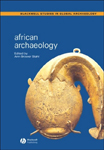
H-NET BOOK REVIEW
Published by H-SAfrica (March, 2007).
Ann Brower Stahl, ed. African Archaeology: A Critical Introduction. Blackwell Studies in Global Archaeology Series. Oxford: Blackwell, 2005. xiv + 490 pp. Index, notes, illustrations, maps. $39.95 (paper), ISBN 978-1-4051-0156-1.
Reviewed by: David Morris, Archaeology Department, McGregor Museum, Kimberley, South Africa.
Not very long ago Africa's history was considered short; and if "men existed" in the "dark centuries" preceding the advent of the Portuguese, it was felt that they fell more within the province of anthropology than of history. Such was the view of historian Hugh Trevor-Roper, cited in the preface to a work offered as a corrective, the groundbreaking 1969 Oxford History of South Africa.[1] As notoriously, the continent's pre-colonial past was characterized by Trevor-Roper as "the unrewarding gyrations of barbarous tribes in picturesque but irrelevant corners of the globe" (quoted, pp. 11, 24). Archaeologists could demonstrate a different view. Indeed, Thurston Shaw would respond to historians who were dubious about archaeology's role in writing African history, that "there is much more information about the African past waiting to be revealed by archaeological methods than historical"; and "there ought," he challenged, "to be more archaeologists in African universities than historians."[2]
African Archaeology: A Critical Introduction, edited by Ann Brower Stahl, is testimony to just how fundamentally wrong and prejudiced the Trevor-Ropers of this world had been; and it is also, no doubt, a vindication of Shaw's defense. Against the short-history view, there can be no question but that archaeology has served this continent well: from often intractable -- and fragile -- material traces, using methods and techniques now increasingly refined and reflexive, it constructs a past which is immensely rich, and a history which stretches back far further than was once imagined. In expanding our temporal and spatial frames of reference this is a discipline that has, as Bruce Trigger remarked, irretrievably altered the range and quality of human thought.[3] Alongside paleoanthropology, archeology now situates Africa center-stage, not as the forgotten cul-de-sac it once was, but as a place indeed of common human origins (however, see below).
The first of two stated objectives of this book are to give some account of the breadth of history revealed by archeology in Africa. The book does so admirably well, by way of eighteen chapters commissioned from specialists in their respective fields. Geographic coverage is not without certain gaps, which are acknowledged by the editor: publisher's page restrictions impose constraints, she pleads, and choices had to be made. The bias falls in favor of sub-Saharan Africa as against the Mediterranean, the Nile and the Horn (references are provided for those who would delve there). Each contribution (explicitly highlighting current debates at the editor's urging) is concluded with a comprehensive bibliography, so that readers have a means to read deeper. The editor has students in mind: the book is part of the Blackwell Studies in Global Archaeology series, which is designed "to cover central areas of undergraduate archaeological teaching" (p. vii). I should think this book would be valued more widely, for example, it would be of the greatest interest to any student of Africa more generally.
The second goal of the book is arguably the more important one. As well as presenting current understandings and debates, the editor and contributors seek to foster a critical awareness of the contexts that have shaped archeological knowledge of Africa's pasts, and of the evidence and epistemologies, preoccupations and assumptions on which it is based. What were the impacts, for instance, of that view of timeless "dark centuries" more anthropological than historical, punted by the above-mentioned Oxford historian? More pertinently, Stahl assesses the way -- and by whom -- archeological significance in Africa is valued today. In her introduction, she critiques current images of the African past relative to the conventional narrative, what she terms the project of world prehistory. This Enlightenment-inspired universal "human story" turns the spotlight to Africa, as it must, for human origins and our earliest history; but it then trails off as "our story" unfolds elsewhere in subsequent episodes on the origins of domestication, civilization, and so on. As the inclusive "we" of the narrative becomes more select, later periods in African prehistory become implicitly excluded; their relevance relegated to the status of a parochial "them" -- no longer part of the "us" of universal human history. Insofar as archeologists had rallied to Africa's cause to demonstrate a proud history of innovation and social complexity -- in the face of perspectives epitomized by that of Trevor-Roper -- they were able to counter the negative images at the level of detail, Stahl argues; but not at the level of their underlying presumptions. The denial of Africa's role, to be sure, had been substituted with a positive insistence on its place in prehistory, but the broader framing of world prehistory has remained very much as the master script. This book should go some way towards motivating students to engage critically in the archeology and the pasts of this continent. For practicing archeologists, it issues this challenge "to use emerging knowledge of Africa's pasts in reformulating the project of world prehistory" (p. 16).
Paul Lane's chapter, on "Barbarous Tribes and Unrewarding Gyrations? The Changing Role of Ethnographic Imagination in African Archaeology," presents an assessment of analogical modeling and reasoning (ethnographic as well as taphonomic, i.e., site formation processes) as one of the key interpretive methods used by archeologists. At worst, in this respect, Africa had been mined for "primitives" as "living fossils" to illustrate evolutionary stages; and Lane shows that the ghosts of such earlier perceptions may still haunt some of the recent applications. One might have expected here some assessment of the use of ethnography in the study of rock art, which has made for something of a paradigm shift with ramifications well beyond rock art itself in South Africa since the 1970s.[4] It is often not so much new evidence but new questions and perspectives, Stahl suggests, that has brought about change in the way Africa's past is known.
The sixteen remaining chapters form the substance of this book, variously engaging with the state of knowledge in a region or in a subject area. Thomas Plummer looks into the archeology of our oldest known technology in a chapter on "Discord after Discard: Reconstructing Aspects of Oldowan Hominin Behavior." The archeology of Pleistocene Africa, and the emergence here of one species, Homo sapiens, is a focus of chapters by Curtis Marean and Zelalem Assefa ("The Middle and Upper Pleistocene African Record for the Biological and Behavioral Origins of Modern Humans") and Hilary Deacon and Sarah Wurz ("A Late Pleistocene Archive of Life at the Coast, Klasies River"). A series of chapters follow that focus on subsistence strategies, and trends towards intensification, through the Holocene. Here are Peter Mitchell's "Modeling Later Stone Age Societies in Southern Africa," Augustin Holl's "Holocene 'Aquatic' Adaptations in North Tropical Africa," Diane Gifford-Gonzalez on "Pastoralism and Its Consequences," Joanna Casey's chapter "Holocene Occupations of the Forest and Savanna," and Katharina Neumann's thoughts as an archeobotanist on "The Romance of Farming: Plant Cultivation and Domestication in Africa."
Specific topics, more than regions or periods, are the subject of a succeeding set of chapters, including "Metallurgy and Its Consequences," by Terry Childs and Eugenia Herbert, and "The Bantu Problem and African Archaeology," an essay on historical linguistic modeling by Manfred Eggert, along with Adria LaViolette and Jeffrey Fleisher's "The Archaeology of Sub-Saharan Urbanism: Cities and Their Countrysides." These chapters establish some of the framing issues against which particular regional debates have been transacted. One of the most hotly contested of them is the Kalahari debate, reviewed by Andrew Reid ("Interaction, Marginalisation and the Archaeology of the Kalahari"). Gilbert Pwiti examines a multi-causal framework for discussing the period of state formation in "Southern Africa and the East African Coast," while complex trajectories of change and continuity, unsettling older conceptions of ethnicity or evolutionary cultural transitions, are themes in the chapters by Chapurukha Kusimba and Sibel Kusimba ("Mosaics and Interactions: East Africa 2000 B.P. to the Present"), by Pierre de Maret ("From Pottery Groups to Ethnic Groups in Central Africa"), and by Scott MacEachern ("Two Thousand Years of West African History").
Several authors refer, one way or another, to the contribution archeology could make towards (as de Maret puts it) "relativizing ethnicity and autochthony and its many manipulations that fuel hate and exclusion instead of stressing the common background shared by most" (p. 436). And rejecting the sort of simplistic progressive scheme of cultural evolution that preoccupied earlier scholars, MacEachern remarks, "reality -- like archaeology -- is messier, and more interesting, than that" (p. 458).
If there is a missing chapter, for me it is one on rock art in Africa. A few relevant references are to be found scattered through the book, such as in Mitchell's chapter on the Southern African Later Stone Age (but surprisingly, again, not in the chapter on "The Role of Ethnographic Imagination"). A recent continental overview such as David Coulson and Alec Campbell's African Rock Art: Paintings and Engravings on Stone (2001) was perhaps too general to be included in any of the detailed regional/subject summaries.
On the whole, this book lives up to its editor's claim that this is "an exciting time to be involved [in] African archaeology" (p. 16). Recognizing that archaeological knowledge extends beyond the academy (and, one could add, to other disciplines within it), Stahl urges that those engaged in this work should be concerned about "the kinds of questions we ask, the answers we seek, and the effects of our successive approximations of Africa's pasts on her present and future" (p. 16). African Archaeology: A Critical Introduction will no doubt play its role in these quests.
Notes[1]. Monica Wilson and Leonard Thompson, The Oxford History of South Africa, vol. 1, South Africa to 1870 (Oxford: Clarendon Press, 1969), vii.
[2]. Cited in Ken Smith, The Changing Past: Trends in South African Historical Writing (Johannesburg: Southern Book Publishers, 1988), 141.
[3]. Bruce G. Trigger, A History of Archaeological Thought (Cambridge: Cambridge University Press, 1989), 410.
[4]. J. David Lewis-Williams, "The Evolution of Theory, Method and Technique in Southern Africa Rock Art Research," Journal of Archaeological Method and Theory 13 (2006), 343-377.
Copyright (c) 2007 by H-Net, all rights reserved. H-Net permits the redistribution and reprinting of this work for nonprofit, educational purposes.
[Return to table of contents]
